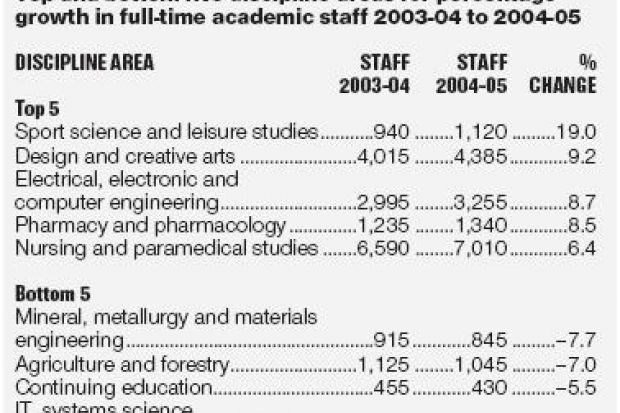Tony Tysome surveys changing employment trends in academe
Sport science and leisure studies has become the fastest growing field for jobs in higher education, a snapshot of movements in the academic employment market has revealed.
Over two years, the number of academics employed full time in this area has risen by 19 per cent - more than double the growth rate of staff recruitment in any other discipline and more than seven times that of the sector overall.
A Times Higher analysis of data supplied by the Higher Education Statistics Agency shows that between 2003-04 and 2004-05, the last year for which figures are available, the number of full-time academics in sport science and leisure studies rose by 180 to 1,120.
The recent mushrooming in the number of leisure and events management courses could explain the apparent recruitment drive in sport science and leisure studies, according to Nina Becket, assistant director of the Higher Education Academy subject centre for hospitality, leisure, sport and tourism.
She said: "Sport and exercise science is a long-standing area in the sector. But now we are seeing huge growth in sport and leisure-related courses. There is a lot of diversity in the field, which includes events management, adventure and outdoor education. That means academics with a wide range of expertise are needed, from physiology to the history of sport."
Even more impressive in absolute numbers, however, was expansion in recruitment of academics into nursing and paramedical studies, and into design and the creative arts.
In the first, 420 full-time academics were added, the biggest rise in staff numbers in the sector. In the second, an extra 370 full-time academics were brought in, representing a 9 per cent rise in the number working in this area, the second largest percentage increase of all discipline fields.
David Clews, manager of the HEA subject centre for art, design and media, said rapid growth in the number of courses and, perhaps, the shifting of hourly paid staff on to full-time contracts could explain growth in his area.
Not far behind this field in growth terms is electrical, electronic and computer engineering, which had an 8.7 per cent staffing boost and took on an additional 260 academics.
But in other engineering fields, the picture is bleaker. Minerals, metallurgy and materials engineering experienced the biggest percentage fall in numbers, shedding 70 staff - a 7.7 per cent drop.
General engineering lost 90 academics (down 3.4 per cent) - the most of any subject area - while information technology and systems sciences and computer software engineering lost 85 staff (a 4.9 per cent drop).
Staff numbers in aero-mechanical and production engineering fell by 55 (down 2 per cent), and civil engineering lost 35 academics (a 3.3 per cent fall).
Outside engineering, agriculture and forestry saw the biggest fall in full-time staff numbers, losing 80 academics, representing 7 per cent of its workforce.
John Dickens, director of the engineering subject centre, said changes in student numbers could take years to feed into the academic jobs market.
"Electrical engineering is showing a fall in student applications this year, while civil engineering is the most buoyant. I think that these things tend to go in cycles, and inertia in the system means that it can be a while before you can recognise a trend in academic employment."
tony.tysome@thes.co.uk </a>
Register to continue
Why register?
- Registration is free and only takes a moment
- Once registered, you can read 3 articles a month
- Sign up for our newsletter
Subscribe
Or subscribe for unlimited access to:
- Unlimited access to news, views, insights & reviews
- Digital editions
- Digital access to THE’s university and college rankings analysis
Already registered or a current subscriber? Login
